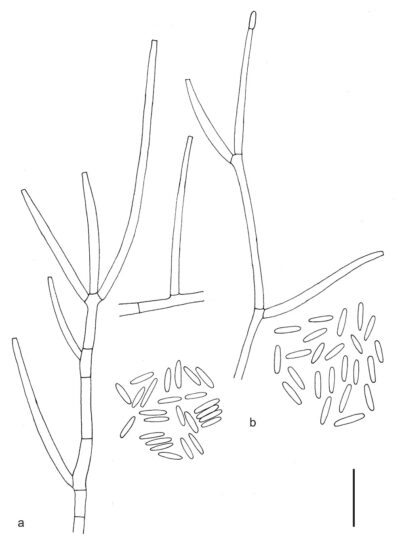Fungalpedia – Note 302, Leptobacillium
Leptobacillium Zare & W. Gams
Citation when using this entry: Perera et al. 2024 (in prep) – Fungalpedia, genera described in 2016.
Index Fungorum, Facesoffungi, MycoBank, GenBank, Fig. 1
Classification: Cordycipitaceae, Hypocreales, Hypocreomycetidae, Sordariomycetes, Pezizomycotina, Ascomycota, Fungi
Based on LSU sequence data, Zare & Gams (2016) established Leptobacillium to accommodate four verticillium-like species that produce whitish colonies and erect conidiophores. Leptobacillium species are saprotrophic or sometimes fungicolous (Zare & Gams 2016). Species of the genus are characterized by white, greyish white or pinkish white to cream-coloured and woolly colonies on PDA. Reverse of the colony are orange to orange-brown, ochraceous, pale luteous, milky white to dark buff and sometimes diffuse yellow pigment. The asexual morph is hyphomycetous with conidiophores that are primarily long, solitary phialides and rarely irregularly branched. Rod-shaped to slightly fusiform conidia occur in very long, slender chains. Those chains are hardly distinguishable from simple hyphae. The initial conidium is usually shorter, clavate to pyriform, and has a rounded distal end. Chlamydospores are not formed on PDA. Octahedral crystals are usually present. The sexual morph remains undetermined (Zare & Gams 2016). To date there are eight Leptobacillium species have been recorded (Index Fungorum 2023).
Type species: Leptobacillium leptobactrum (W. Gams) Zare & W. Gams
Other accepted species: Species Fungorum – search Leptobacillium.
Figure 1 – Leptobacillium leptobactrum (a: CBS 775.69, b: CBS 145.68). a, b Conidiophores and conidia. Scale bar: a, b = 10 μm. Redrawn from Zare & Gams (2016).
Reference
Entry by
Rekhani Hansika Perera, Center of Excellence in Fungal Research, Mae Fah Luang University, Chiang Rai, 57100, Thailand.
(Edited by Kevin D. Hyde, Samaneh Chaharmiri-Dokhaharani, & Achala R. Rathnayaka)
Published online 8 July 2024
